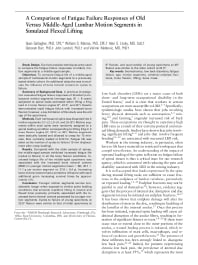Mining Publication: A Comparison of Fatigue Failure Responses of Old Versus Middle-Aged Lumbar Motion Segments in Simulated Flexed Lifting
Original creation date: August 2007
Authors: S Gallagher, WS Marras, AS Litsky, D Burr, J Landoll, V Matkovic
Study Design: Survival analysis techniques were used to compare the fatigue failure responses of elderly motion segments to a middle-aged sample. Objectives: To compare fatigue life of a middle-aged sample of lumbosacral motion segments to a previously tested elderly cohort. An additional objective was to evaluate the influence of bone mineral content on cycles to failure. Summary of Background Data: A previous investigation evaluated fatigue failure responses of 36 elderly lumbosacral motion segments (average age, 81 +/- 8 years) subjected to spinal loads estimated when lifting a 9-kg load in 3 torso flexion angles (0°, 22.5°, and 45°). Results demonstrated rapid fatigue failure with increased torso flexion; however, a key limitation of this study was the old age of the specimens. Methods: Each lumbosacral spine was dissected into 3 motion segments (L1-L2, L3-L4, and L5-S1). Motion segments within each spine were randomly assigned to a spinal loading condition corresponding to lifting 9 kg in 3 torso flexion angles (0°, 22.5°, or 45°). Motion segments were statically loaded and allowed to creep for 15 minutes, then cyclically loaded at 0.33 Hz. Fatigue life was taken as the number of cycles to failure (10 mm displacement after creep loading). Results: Compared with the older sample of spines, the middle-aged sample exhibited increased fatigue life (cycles to failure) in all the torso flexion conditions. Increased fatigue life of the middle-aged specimens was associated with the increased bone mineral content (BMC) in younger motion segments (mean +/- SD, 30.7 +/- 11.1 g per motion segment vs. 27.8 +/- 9.4 g). Increasing bone mineral content had a protective influence with each additional gram increasing survival times by approximately 12%. Conclusion: Younger motion segments survive considerably longer when exposed to similar spine loading conditions that simulate repetitive lifting in neutral and flexed torso postures, primarily associated with the increased bone mineral content possessed by younger motion segments. Cycles to failure of young specimens at 22.5° flexion were similar to that of older specimens at 0° flexion, and survivorship of young specimens at 45° flexion was similar to the older cohort at 22.5°.

- Biomechanical Modeling of Asymmetric Lifting Tasks in Constrained Lifting Postures
- Effects of Lifting in Four Restricted Postures
- Effects of Posture on Back Strength and Lifting Capacity
- Effects of Posture on Dynamic Back Loading During a Cable Lifting Task
- An Exploratory Study of Loading and Morphometric Factors Associated with Specific Failure Modes in Fatigue Testing of Lumbar Motion Segments
- Nature and Cost of Low Back Pain
- Reducing Low Back Pain and Disability in Mining
- Technology News 521 - Development of a Mobile Manipulator to Reduce Lifting Accidents
- Torso Flexion Loads and Fatigue Failure Mode of Human Lumbosacral Motion Segments
- Trunk Extension Strength and Muscle Activity in Standing and Kneeling Postures